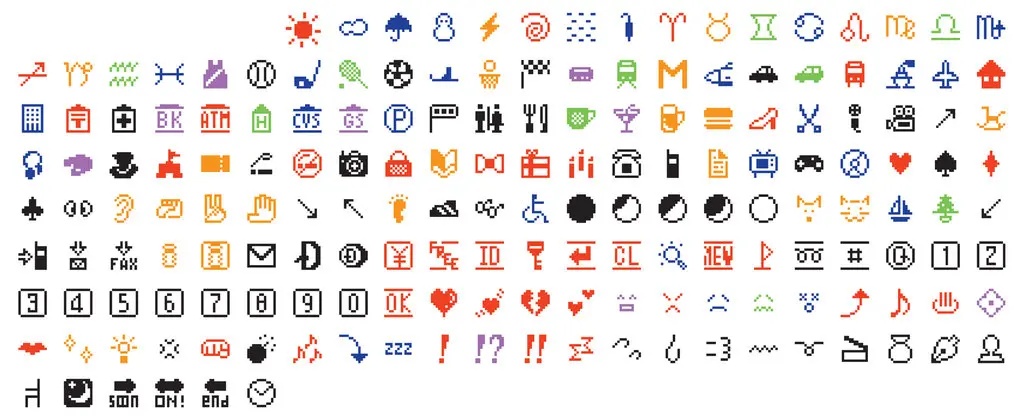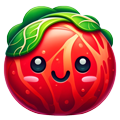Makeup Exercise: AI Emoji

Dumpling Emoji
Emojis are a fundamental part of communication today, as integrated features/keyboards in most personal computers and messaging services. While the omnipresence of emojis, and their exhuastive character set, may give them impression they are a universal complete "alphabet".

First set of emoji designed by Shigetaka Kurita
However, they are a recent project. Invented in 1999 by Shigetaka Kurita for Japanese company NTT DoCoMo's i-mode mobile platform. This 176 character set took inspiration from Manga, and "manpu" – visual representations of character's internal feelings. As well as emoticons – "textual portrayals of a writer's moods or facial expressions" (Wikipedia) which use text to create symbols :-]. NTT DoCoMo's emojis quickly became a popular feature of the program, leading to various competitors creating their own features and designs.

Dead Emoji by Shigetaka Kurita
Up until the late 2000s, various companies and individuals would create their own keyboards and application features to bring emoji into messenger applications. In 2007 however, Google began to lobby the Unicode Consortium – the body which governs Unicode, a standard for which language is encoded for use in computers – to officially recognize Unicode. While this effort took place, Apple and Google began to integrate emoji into their products, with Emoji officially being included in Unicode 6.0 in 2010.
While emojis have been celebrated and embraced as a boundary-free communication method, their limitations have become clear over time – such as their lack of cultural and ethnic diversity, as well as problematic signs and symbols guns 🔫 (⬅️ since replaced with a water gun) and bombs 💣 , or offensive symbols such as the middle finger 🖕. The Unicode Consortium has attempted to address these shortcomings, in 2012 for instance introducing same-sex couple 👬 emojis, and in 2015 introducing skin-color 🧑🧑🏻🧑🏼🧑🏽🧑🏾🧑🏿.
🥟
In 2015 designer Yiying Lu, along with her colleagues at Emojination, started a campaign to create the dumpling emoji. On their kickstarter page they wrote:
Dumplings are one of the most universal cross-cultural foods in the world. Poland has pierogi. Nepal has momos. Russia has pelmeni, Japan has gyoza. Italy has ravioli. Georgia has khinkali. Korea has mandoo. Jews have kreplach. Argentina has empanadas, and China has potstickers.
Yet, there is no dumpling emoji.
There is a pizza emoji, a hamburger emoji and a taco emoji. There are also a range of semi-obscure Japanese foods including fish cake with swirl design, rice ball, and dango. But there is no usable dumpling emoji in the standard set.
There’s a time to change that and that time is now.
In their lobbying campaign they cited that the approval of emoji is controlled by the Unicode Consortium, a group of primarily tech companies who pay a large fee (at the time $18,000usd annually) for the privilege of administering Unicode. Today "there are nine full members [of the Unicode Consoritum], all of which are tech companies: Adobe, Airbnb, Apple, Google, Meta, Microsoft, Netflix, Salesforce, and Translated" (Wikipedia). Emojination's campaign was successful, and in 2017 the dumpling emoji became available for use in Unicode.
Emojination's story points out the centralized control over such an important facet of language, with a unique overlap in design as primarily signs and visual language. While the dumpling emoji is a success story, hundreds of emoji proposals have been declined, leading us to naturally speculate what important subgroups, emotions, and concepts are being excluded?
In this exercise, you will analyze the existing emoji character set, and visualize your own emoji to add to the list. To do this, I'd like you to use an AI drawing tool to create your emoji's design. Like emoji, AI drawing tools promise infinite visual styles, and the ability to depict as diverse outcomes as our imaginations can conceive. Yet, AI drawing tools exhibit bias, and their training processes violate our collective sense of decency as they either explicitly break terms of service, or a common sense of decency, to collect their visual materials for training. Like emoji, AI Drawing tools – with their opaque processes and limited perspectives – may seem universal, but are in fact prejiduced. Let's consider the nuances of these two formats by creating and sharing our emojis.
Instructions

Kimchi emoji created by ChatGPT
Part 1: Emoji
Using an AI Drawing tool, create an emoji of your choice. When deciding on your emoji, consider what is lacking in the current emoji character set, as well as what would be a provocative inclusion.
As you experiment with your drawing tool(s), consider the platform(s) for which your emoji are being drawn. What addtional layers of complexity are added in device-specific rendering? And how are the various meanings of a concept translated by their rendering style? Keep track of how you adjust your prompts to create the emoji you desire.
Reflect on how the limitations of the AI drawing tools lead to certain formal outcomes. And your levels of satisfaction and dissatisfaction with them as a result. Be analytical in your assessment of their results.
If you cannot get the results you intend from an AI tool, you can draw the emoji yourself.
🌐
Part 2: Emoji "Specimen" Website
Now that you’ve chosen and visualized your emoji, create an HTML webpage that acts as a "specimen" for your emoji. It's common practice in typeface promotion to showcase the typefaces form, features, and story in an online specimen. These websites can be as simple as a few images and descriptive text, or creative and full featured applications and narratives.
Create your own "emoji type specimen" to share about your emoji's design and narrative. If you'd like, you could create a family of emoji, or a larger augmentation to emoji you propose.
At its bare minimum, you can use the below starter code for your website (simply copy it into your own text file and save as index.html, replacing the basic info with your own content):
<!DOCTYPE html>
<html>
<head>
<meta charset="utf-8">
<meta name="viewport" content="width=device-width, initial-scale=1">
<title>[My Emoji Specimen]</title>
</head>
<body>
<header>
<!-- put image of your emoji here -->
<img src="" />
</header>
<main>
<p>[The story of my emoji]</p>
</main>
</body>
</html>Consider adding previous versions, the prompts ysed to create your emoji, hover states, animations, and interactive features to tell the story of and embody your emoji's concept and ethos in the webpage.
Don't forget to integrate CSS into your site to create the aesthetic impression you desire.
Upload and link your AI Emoji specimen website from your personal class site by May 20.
Resources
- List of all Emojis
- ChatGPT
- Midjourney
- DeepAI: AI Image Generator
- Canva: AI Image Generator
- Pixlr: AI Image Generator
- Microsoft AI Image Generator
Emoji References
- Where is the Dumpling Emoji?, Kickstarter by Emojination
- Dumpling Emoji Proposal
- Emoji Timeline
- emojitracker
- The Story of the World's First Emoji, by Madeleine Morley
- The WIRED Guide to Emoji, by Arielle Pardes
Type Specimens References
- typespecimens.io
- Java Sans type specimen
- RT Alias
- GT Eesti
- Work Sans
- Pentameter font specimen (more on Pentameter)
- Dinamo Standards
- GT Maru
AI References
- This is how AI image generators see the world, by Washington Post
- Awful AI, by @dwddao
- Humans Are Biased. Generative AI Is Even Worse, By Leonardo Nicoletti and Dina Bass Technology